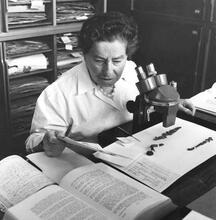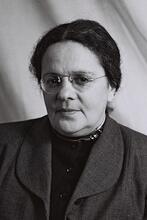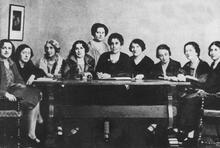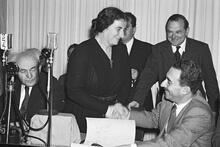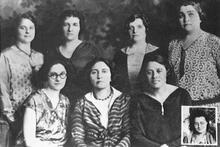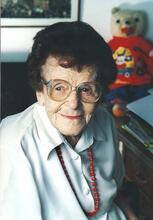Rahel Katznelson
Rahel Katznelson, born in 1885 in Russia, moved to Israel in 1912 out of a personal desire for a life of meaningful Jewish creativity. While her education and abilities could have won her entry into the country’s intelligentsia, she chose to join the pioneers of the Second Aliyah, whom she viewed as the true proponents of the Jewish social and cultural “revolution.” Katznelson contributed greatly to the country’s emerging cultural life, laying stress on women’s participation within it. In addition to her work in the cultural sphere, she was also asked to fill a number of public positions, from representing Israel at international conferences for socialist women to appearing before the United Nations Special Committee on Palestine (UNSCOP) on behalf of the country’s Jewish women.
Background and Early Life
A thinker and teacher, Rahel Katznelson was one of the early activists in the Labor Movement and Mo’ezet ha-Po’alot in the Jewish community in Palestine prior to the establishment of the State of Israel. "Old Yishuv" refers to the Jewish community prior to 1882; "New Yishuv" to that following 1882.Yishuv and Israel.
In a letter to Dr. Yehudit Harari of August 28, 1956, Katznelson summed up her concurrent public activity in three areas: “Cultural activity among members of the Labor Movement; activity—mainly cultural—among women workers; and literary criticism.”
Katznelson was born in Bobruisk, Russia (now Babruysk, Belarus) on October 25, 1885 (15 Heshvan 5646), the second of the six children of Zelda (née Rozovsky) and Nisan Katznelson. The family was prosperous, modern-religious, and educated, earning their income as lumber merchants doing business with the southern region of Russia.
Rahel’s intellectual gifts were evident from childhood. After finishing her studies at the local grammar school at the age of twelve, she was sent to study at the gymnasia for girls in Kremenchuk in the Ukraine, where she spent six years. She absorbed culture and Russian literature to the point where she became “drunk on assimilation,” as she described it. In 1903 she graduated with honors, returning home with a gold medal that enabled her to open the doors of any university in Russia, despite being Jewish.
The reunion with her family and with her Jewish environment, coupled with the pogroms against the Jews of Kishinev that same year, led to an awakening and a decision to become acquainted with her own people’s culture before continuing her academic studies. She remained in Bobruisk for four years, studying Hebrew and Bible and becoming acquainted with the new Hebrew literature and with Yiddish popular literature. She joined the Zionist-Socialist Workers’ Movement in her city, taught Jewish women workers who had not received an education, taught Hebrew literacy to youth groups, and wrote an essay in Russian on the poetry of Hayyim Nahman Bialik (1873–1934).
She spent 1908 in Berlin, where she attended lectures at the seminary for Jewish studies, learned German and became acquainted with music, art ,and classic Western literature.
At the end of the year, Katznelson returned to Russia and registered to study Russian literature and history at the women’s university in St. Petersburg. At the same time, she registered for Jewish history at the Academy of Jewish Studies founded in the city that year. There she met a fellow student, Shneur Zalman Rubashov (1889–1974, later her husband, Zalman Shazar, third president of Israel), with whom she developed a relationship.
Early Writing Career and Relocation to Israel
Katznelson’s academic success strengthened her belief that she was meant to be a writer and literary critic. In St. Petersburg she had the opportunity to study both classical Russian literature and modern Hebrew literature in depth. Comparing the richness of Russian culture in the city with the feeble attempts to create a modern Hebrew culture there, she sadly wrote in her diary: “Have we no more than this?” On the other hand, she realized that as a Jewish woman she would never be able to put her achievements to use as an equal participant in the Russian artistic world. Hence her place was with her own people’s culture, though she felt that it was impossible to create true non-religious Jewish art in the Lit. (Greek) "dispersion." The Jewish community, and its areas of residence, outside Erez Israel.Diaspora.
Once she had reached this conclusion, Katznelson saw no point in continuing her studies. In addition, health problems and a (temporary) crisis in her relationship with Zalman Rubashov caused her to interrupt her studies and leave St. Petersburg in 1911. She searched for a place where she could find meaning in life and create freely. Her two close friends, Zalman Rubashov, who had returned from a trip to Palestine, and Berl Katznelson (1887–1944; not a relative), who had emigrated there the year before, tried to persuade her to move there as well. She recalls that as far as she was concerned, the deciding factor was a literary one—a story written by the The Land of IsraelErez Israel author Joseph Hayyim Brenner (1881–1921), “From Here and There” (1911). This story, which describes the emotional and material struggles of the pioneer in Erez Israel and Brenner’s own inner conflicts, aroused feelings of personal identification in Katznelson. She felt that this was the place where she herself would find an appropriate atmosphere. She reached the coast of Jaffa on November 7, 1912.
Working Woman
On November 7, 1913, after a difficult year of acclimation and searching, Katznelson was engaged to teach Hebrew and history at the women’s agricultural farm at Kinneret founded by Hannah Maisel-Shohat. There she forged ties with the group of worker pioneers, members of the Second Lit. "ascent." A "calling up" to the Torah during its reading in the synagogue.Aliyah (1904–1914) whom she saw as “the elect.” In 1918, she wrote of them in her diary: “My realization that we are living the most cultural and complicated lives […] is correct.” In order to be one of the elect, she felt that she must also engage in physical labor. Thus, from the end of 1914 to 1919, she worked as a laborer at Tel Adashim and at Kevuzat Kinneret, in Jerusalem and at Ritual bathMikveh Israel.
At the second women workers’ conference, held at Kinneret in 1915, Katznelson was elected to the workers’ committee. In the same year she was also elected to the Galilee Workers’ Cultural Committee, where she and her colleagues taught workers on Sabbaths and in the evenings after work. In 1919 Katznelson was active in founding the Zionist Socialist Labor Party (Ahdut ha-Avodah) and was elected to serve full-time on its cultural committee. She left her job at Mikveh Israel and began to occupy herself with the cultural needs of workers throughout the country, providing mobile libraries, classes and lectures for adults and educational frameworks for children.
Though Rahel Katznelson did not distinguish herself in field labor or kitchen work, she was one of the few women of the Second Aliyah whose male colleagues were willing to listen to and learn from, despite their dismissive attitude toward other women colleagues. Such treatment infuriated her, and she felt obligated to do all she could to change it. In 1914 she participated in the founding convention of the women workers’ movement at Merhavyah, remaining active in it from then on and becoming one of its major leaders.
Family Life
When World War I broke out in 1914, Zalman Rubashov, who was studying at a German university, was arrested in Berlin as an enemy alien, due to his Russian nationality, and forbidden to leave the city until the end of the war. He reached Palestine in 1920 and resumed his relationship with Rahel Katznelson. They were married on April 19, 1920 (Rosh Hodesh Iyyar 5680), in Jerusalem. In the same year he was elected to the central committee of Po’alei Zion in Vienna, where the couple spent the next four years and where their only daughter, Rhoda, was born on February 14, 1921. Rhoda had Down Syndrome and her parents’ concern for her growth and education occupied them all their lives.
In 1924 they returned to Palestine and settled in Tel Aviv. Zalman Rubashov served on the editorial board of the workers’ newspaper, Davar (founded 1925), while Rahel joined the Histadrut’s cultural committee, where she helped develop its educational network, Hebrew-language studies for immigrants and a central library.
Writing Career
In 1928 Katznelson began to work at the Mo’ezet ha-Po’alot (Council of Women Workers), where she sought to implement her ideas on promoting working women’s participation in the community life then taking shape in the country. The first pre-requisite for this was, in her opinion, education for women and encouragement of their self-expression. Mo’ezet ha-Po’alot accepted her proposal to publish a book about the life of the working woman, putting her in charge of the project. The collection Divrei Po’alot, edited by Katznelson, appeared in 1930. In it, fifty-seven women of the Second and Third Aliyah (1919–1923) wrote about their lives, creating a work that in the course of about twenty years became an educational-historical document providing the first authentic expression of working women’s lives in pre-state Israel. Translated into four languages—Yiddish, German, Bulgarian and English (as The Plough Woman, 1932, translated by Maurice Samuel)—the book served as educational material in pre-state Israel and the Diaspora. In the same year, Rahel Katznelson joined the secretariat of the Mo’ezet ha-Po’alot.
Following the success of Divrei Po’alot, Rahel Katznelson initiated a regular publication that would reflect the lives of working women and serve them as a platform for self-expression. The women’s monthly Devar ha-Po’elet first appeared in March 1934, with Katznelson as editor, and continued its monthly appearance (from 1976 under the name Na’amat) until the 1990s.
In 1964 Rahel Katznelson described the mission of Devar ha-Po’elet thus: “It is the Jewish woman’s first regular Hebrew platform: to live as workers, mothers, defenders and settlers of the land and draw from them, through listening and love, the faithful expression of many and the creativity of individuals.” This was not a “women’s newspaper” in the conventional sense. The editor and her colleagues on the board were careful to maintain a high level in the material and a variety of subjects, inter alia: women in Palestine and the world, current affairs, literature, culture, and art. While the writers were mostly women, the articles were intended for the general public. This created an opening for the recognition, understanding and appreciation of women’s role in society.
Rahel Katznelson did not content herself with the written word. In addition to editing Devar ha-Po’elet, she organized classes and ideological seminars for women, participating in them as teacher and lecturer. It was important for her that women meet not only about practical matters, but also to study and expand their horizons.
Katznelson also participated in ideological seminars in the Diaspora: in 1938 she served as a lecturer and board member in a seminar for the Halutz youth movement in Warsaw and after the war, in 1947, she organized a seminar for young Holocaust survivors in Münchberg, Germany.
In addition to her work in the cultural sphere, she was also asked to fill a number of public positions: in 1933 she was active on behalf of Mo’ezet ha-Po’alot in its counterpart in America and Canada, the Pioneer Women. She represented Israel at international conferences for socialist women, was a Histadrut delegate to the Zionist Congress, was elected to the Executive Committee of the World Zionist Organization, was a member of the Histadrut’s Workers’ Executive Committee, and a member of the central committee of Mapai. In the summer of 1947, she appeared together with Rebecca Sieff before the United Nations Special Committee on Palestine (UNSCOP), on behalf of the country’s Jewish women. In 1958 she was awarded the Israel Prize for her social and cultural activities on behalf of women.
For more than twenty-five consecutive years, Rahel Katznelson edited Devar ha-Po’elet, where she published many of her literary articles. But throughout her life in Israel, she published only four profound, wide-ranging literary essays, some of which serve researchers to this day. She wrote to Dr. Yehudit Harari on the process of writing those essays: “From time to time, I would discover an author with whom I felt a close affinity and would concentrate on him. … In every period, there was one Hebrew author who served me as a kind of spiritual center. … Those essays were a kind of research and required conditions that only rarely prevailed. The demands of work and family left me little time for that kind of writing.”
Katznelson’s first Hebrew essay, “Nedudei Lashon” (Wanderings of Language), was published in 1918 in the collection Ba-Avodah (At Work). In response, Berl Katznelson wrote to her: “This is the beginning of the living essay in our literature.” She published three more essays: on Uri Nissan-Gnessin (1879–1913) (1927), Micha-Josef Berdyczewski (1865–1921) (1941), and Joseph Hayyim Brenner (1942). In 1946 she published her collected works in Essays and Articles, which was awarded that year’s Brenner Prize. An expanded edition of this book, Al Admat ha-Ivrit (On Hebrew Soil), was published in 1966. Im Pa’amei ha-Dor (In the Steps of the Generation), a two-volume anthology which she edited on the occasion of the twenty-fifth anniversary of Devar ha-Po’elet, appeared in 1964. Two additional books were published posthumously: Adam Kemo she-Hu (The Person as She Was, 1989), her personal diaries from 1907 to 1972, and Ha-Hofim ha-Shenayim (The Two Shores, 1999), an exchange of correspondence between herself and Zalman Rubashov-Shazar from 1909 to 1963.
On May 22, 1963, Zalman Shazar was elected third president of the State of Israel. Rahel, now seventy-eight years of age, had new tasks to fulfill, which she did honorably until 1972, when she fell ill and underwent surgery. She never returned to full health or to her home, dying on August 11, 1975 (4 Elul 5735).
Rahel Katznelson came to Erez Israel out of a personal desire for a life of meaningful Jewish creativity. While her education and abilities could have won her entry into the country’s intelligentsia, she chose to join the pioneers of the Second Aliyah, whom she viewed as the true proponents of the Jewish social and cultural “revolution.” She contributed greatly to the country’s emerging cultural life, laying stress on women’s participation within it.
Selected Works by Rahel Katznelson
Massot u-Reshimot (Essays and Articles). Tel Aviv: 1944. Literary essays about Jewish and Russian authors and short articles written between 1918 and 1945. Most of them published in Devar ha-Po’elet; Al Admat ha-Ivrit (On Hebrew Soil). Selected Essays. Tel Aviv: 1966; Im Pa’amei ha-Dor (In the Steps of the Generation). Tel Aviv: 1964. A two-volume anthology of selected material from Devar ha-Po’elet, celebrating the journal’s twenty-fifth anniversary.
Divrei Po’alot (translated by Maurice Samuel as The Plough Woman). New York: 1932; Adam Kemo she-Hu (The Person as She Was). Edited by Michal Hagitti. Tel Aviv: 1989.
Personal diaries, letters and articles, 1907–1972. Ha-Hofim ha-Shenayim (The Two Shores). Edited by Michal Hagitti. Jerusalem: 1999.
Correspondence (281 letters) between Rahel Katznelson and Zalman Rubashov-Shazar, 1909–1963, from the time they met in St. Petersburg until his nomination as third president of the State of Israel.
Hebrew
Harari, Yehudit. “Rahel Katznelson.” In A Woman and Mother in Israel. Tel Aviv: 1959, 358–360.
Miron, Dan. “The Conquered Heart.” In Founding Mothers, Stepsisters: The Emergence of the First Hebrew Women Poets and Other Essays. Tel Aviv: 1991, 249–271.
Kolat, Israel. Interview with Rahel Katznelson. Jerusalem: July 1962. The Avraham Harman Institute of Contemporary Jewry at the Hebrew University of Jerusalem, File 161.
Unpublished Manuscripts
Katznelson, Rahel. A letter to Yehudit Harari (Hebrew). November 11. 1956. The Family Archive, Jerusalem.
Katznelson, Rivka. Rahel Katznelson: A Biography. The Family Archive, Jerusalem.


